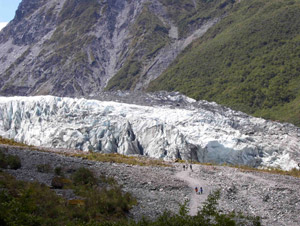A glacier is a large persistent body of ice. Originating on land, a glacier flows slowly due to stresses induced by its weight.
-
 Presently, 10% of land area is covered with glaciers.
Presently, 10% of land area is covered with glaciers. - Glaciers and pack ice contain approximately 75% of the world's fresh water: more than all lakes and rivers, groundwater and water in the atmosphere, combined!
- Glacierized areas cover over 15,000,000 square kilometers.
- Antarctic ice is over 4,200 meters thick in some areas.
- The Antarctic ice sheet has been in existence for at least 40 million years.
- 96.6% of glacierized regions are in Greenland and Antarctica.
- In the United States, glaciers cover over 75,000 square kilometers, with most of the glaciers located in Alaska.
- There are nearly 100,000 glaciers in Alaska, and most of them don't have names.
- During the last Ice Age, glaciers covered 32% of the total land area.
- If all land ice melted, sea level would rise approximately 70 meters worldwide.
- Glacier ice crystals can grow to be as large as baseballs.
- The land underneath parts of the West Antarctic Ice Sheet may be up to 2.5 kilometres below sea level. The weight of the ice pushes the land surface down in a process called isostatic adjustment. The south of the United Kingdom has been slowly rising since the last ice age , due to the weight of all that ice being removed when it melted!
- North America's longest glacier is the Bering Glacier in Alaska, measuring 204 kilometers long.
- Glacial ice often appears blue when it has become very dense. Years of compression gradually make the ice denser over time, forcing out the tiny air pockets between crystals. When glacier ice becomes extremely dense, the ice absorbs all other colors in the spectrum and reflects primarily blue, which is what we see. When glacier ice is white, that usually means that there are many tiny air bubbles still in the ice.
- The Kutiah Glacier in Pakistan holds the record for the fastest glacial surge. In 1953, it raced more than 12 kilometers in three months, averaging about 112 meters per day.
- Fastest moving glacier is found in Antarctica, the Byrd Glacier, moves at approx. 750m/ year, ( 6 feet/ day).
- Vatnajokull is the biggest glacier of them all, found in Iceland, measures 8300 km2.
- The second largest glacier in the world is in Alaska 8000km2, named Malaspina.
- In Washington state alone, glaciers provide 470 billion gallons of water each summer.
- Antarctic ice shelves may calve icebergs that are over 80 kilometers long.
- Almost 90% of an iceberg is below water--only about 10% shows above water.
- The Antarctic ice sheet has been in existence for at least 40 million years.
- From the 17th century to the late 19th century, the world experienced a "Little Ice Age," when temperatures were consistently cool enough for significant glacier advances.
- Life exists on glaciers! The ice worm, less than an inch long, lives on the pollens, insects, minerals and bacteria blown onto the surface of the glacier by the wind.
- Fjords are known to be formed by Glaciers.
- One glacier fact for the next time you are having a drink; glacial-ice-cubes last longer in your drink because the ice crystals are larger, and carry smaller pockets of air bubbles. In case you are tempted to try, just be advised , glacial ice can carry annelid worms which can survive up to 22F.
Sources:
http://en.wikipedia.org/wiki/Ice_worm